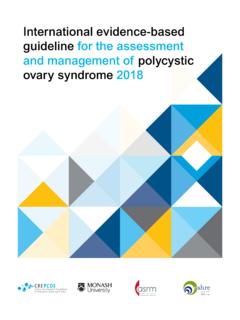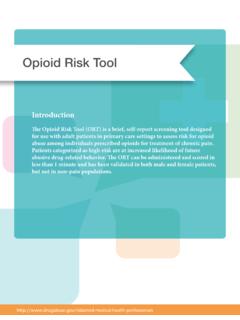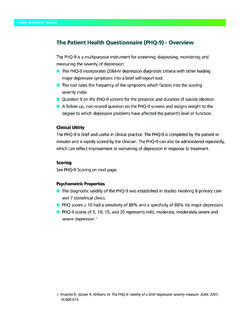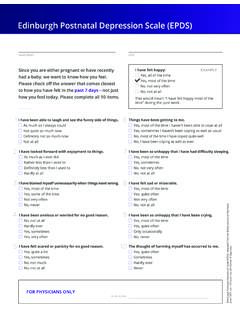Transcription of Assessment & management - Jean Hailes
1 Menopause Health professional tool Assessment & management Phases of female Routine screening reproductive cycle Menopausal women are at increased risk of: Regular cycles heart disease, osteoporosis, central adiposity, mood disorders. premenopause'. Exclude thyroid, diabetes, iron deficiency, drug side effects Change in cycle frequency Bleeding changes recent changes in bleeding pattern including heavy bleeding early perimenopause'. Investigate for iron deficiency and gynaecological pathology Cycles up to 3-12 months apart Check last cervical screening test and mammogram late perimenopause'. Metabolic syndrome monitor BP, cholesterol, blood glucose, abdominal girth and weight Final menstrual period discuss with patient the need to increase activity and monitor caloric intake menopause' (average age 51 years). Bone density see bone health section No menstrual cycles >12 months Smoking discuss with patient the need to cease smoking postmenopause'.
2 Based on symptom report only. Hormonal Key messages screening unreliable due to unpredictable Hot flushes dress in layers, natural fibres, reduce weight, reduce alcohol, increase activity, fluctuations. FSH levels may be helpful in reduce caffeine, healthy diet young women. Dry vagina local treatments: vaginal oestrogen cream, pessaries and tablets. Encourage patients to select vaginal lubricants and moisturisers most similar (in pH and osmolality) Commonly reported to natural vaginal secretions, as this may make them less likely to cause irritation menopausal symptoms {{There are many vaginal lubricants (for use during intercourse) for urogenital symptoms include: and vaginal dryness. Those listed in pink meet the suggested pH and osmolality Fatigue composition: Astroglide , KY Jelly, pjur and Yes . It is also possible to use natural oils Hot flushes Crawling eg olive, sweet almond oil Night sweats {{Vaginal moisturisers (for regular, twice weekly use): Replens , Yes.}}}}
3 Muscle/joint pains sensations Emotional health ask initial screening questions (back page). Anxiety on skin Stress management discuss with patient the need to actively manage stress and mood Irritability Overall eg activity, mindfulness, social connectedness Sleep disturbance diminished Diet phytoestrogen diet may assist in symptom reduction Lessened wellbeing concentration Low libido Use of natural supplementation Vaginal dryness There is some evidence of effectiveness for the following supplements: Painful intercourse Black cohosh (Remifemin and Femular ) decrease hot flushes. Monitor for signs of liver toxicity. HRT/MHT* candidates Women experiencing menopausal Contraindications for HRT/MHT Alternatives to HRT/MHT. symptoms (peri or postmenopause) (consider referral to menopause specialist) Pharmaceutical Dose Women with early or premature menopause Breast cancer (hormonally sensitive) Escitalopram 10-20mgs daily (bone sparing and reduces CVD risk).
4 Women with osteoporosis <60 years Thrombophilia/past venous Venlafaxine daily Women within 5-10 years of last period thrombo-embolic event (VTE) Desvenlafaxine 50-100mgs daily Undiagnosed vaginal bleeding for vasomotor symptoms Paroxetine** Active liver disease daily In general use: lowest effective HRT/MHT dose Gabapentin Uncontrolled hypertension 300-900mgs daily for the short-term relief of menopausal symptoms, CVD risk or disease Clonidine 50-150mcg daily except for early/premature menopause higher dose and long-term therapy. Effectiveness monitored by self-reported symptom control. ** (not to be used with Tamoxifen). Women with a uterus: important to note that HRT/MHT is not a contraceptive Early (<45 years)/ Menopausal transition Postmenopause premature (<40 years) menopause Dosage: lowest effective dose monitored Dosage: lowest effective dose monitored Continue HRT/MHT until 50 years unless by self-reported symptom control by self-reported symptom control contraindicated.
5 Higher doses usually Options: Options: required. 1. Continuous oestrogen 1. Low dose combined contraceptive Options: (if low CVD risk & <50 years) + continuous progestogen 1. Continuous oestrogen 2. Continuous oestrogen (if menopause >1-2 years ago). (high dose oestrogen due to age) 2. Continuous oestrogen + cyclical progestogen 10-14 days each month + cyclical or continuous progestogen + cyclical progestogen + contraception (including barrier, sterilisation) (if menopause <1 year ago). 2. Combined contraceptive 3. Continuous oestrogen or levonorgestrel IUD. 3. Tibolone + levonorgestrel IUD for progestogen and 3. Tibolone (if menopause is >1-2 years ago). contraception 4. Tissue-selective oestrogen complex (TSEC). Review: initially 2-6 months then assess benefits/side effects, address concerns, titrate regimen to suit the individual woman assess need, new development/options, CVD and breast cancer risk.
6 Then annual review. Special considerations After hysterectomy increase in size less likely with tibolone or If atrophic endometrium (<4mms on US), Continuous oestrogen or tibolone. transdermal oestrogen and progestogen. reduce progestin/increase oestrogen. Hirsutism Otherwise, increase progestin dose/. Androgen deficiency length/type; levonorgestrel IUD. Not OCP or oral oestrogen; Oral oestrogen to increase SHBG: cyproterone, dydrogesterone, drospirenone Testosterone therapy use transdermal oestrogen to lower SHBG;. consider testosterone if low calculated free or oral progesterone as progestogen. Remains controversial. No TGA approved testosterone, or tibolone. Can also use spironolactone. preparations. Cream available. Can be Liver disease, gallstones useful for unexplained fatigue + or low Breast cancer libido when blood testosterone levels low. Refer to HRT/MHT contraindications. Vaginal Transdermal.
7 Urogenital symptoms alone oestriol for vaginal and urinary symptoms. Mastalgia Vaginal oestradiol/oestriol regular use Cardiovascular disease (hypertension, Lower dose, transdermal oestrogen, tibolone, 2-3 times weekly. diabetes, hypercholesterolemia) testosterone, evening primrose oil caps. Varicose veins Use transdermal if menopausal symptoms Migraine bothersome. Transdermal or tibolone preferred routes Transdermal oestrogen and progestogen, of administration. Compounded hormones lower dose, avoid oral progestogens;. continuous therapy, not cyclic. VTE/thrombophilia Advise against compounded bioidentical hormone therapy as not TGA approved. Obesity/morbid obesity Assess baseline risk; high risk if VTE. recurrent, spontaneous, with pregnancy/. Endometrial cancer Transdermal. OCP, family history, smokers; screen for Tibolone or HRT/MHT (refer to menopause Ovarian cancer inherited thrombophilia. expert/liaise with oncologist/gynaecologist), No special regimen.
8 Liaise with oncologist/ If normal and low risk, use transdermal usually only stage 1. gynaecologist, as some cancers are or tibolone. Endometriosis hormonally sensitive. If high risk or inherited thrombophilia, OCP, levonorgestrel IUD + oestrogen, Progestogen side effect avoid HRT/MHT unless anticoagulated;. tibolone, continuous combined HRT/MHT; Change progestogen, tibolone. seek specialist haematological advice with post-surgical menopause need to re use of transdermal HRT/MHT. PV bleeding consider added progestogen/tibolone. Investigate to determine cause and exclude Weight increase Fibroids pathology prior to treatment transvaginal Not related to HRT/MHT. No special regimen; theoretically may ultrasound +/ hysteroscopy. Bone health Indications for bone density Assessment : Some chronic diseases eg rheumatoid arthritis, Family history of osteoporosis chronic liver or kidney disease Overactive thyroid or parathyroid Corticosteroid use or exposure Malabsorption eg coeliac disease, inflammatory Some medicines for breast cancer and epilepsy bowel disease and some antidepressants Osteoporosis Osteopenia Normal T-score below T-score between to T-score above Rx aim: prevent further bone loss and fracture Rx aim: prevent further bone loss Rx aim: prevent further bone loss and fracture Plain X-ray thoracic lumbar spine to exclude Plain X-ray thoracic-lumbar spine to exclude Regular weight bearing exercise, optimise compression fracture compression fracture calcium intake + vit D levels Exclude other causes.
9 Regular weight bearing exercise, optimise Monitor bone density at 70 years or earlier Calcium, phosphate, vit D, PTH, TFT, LFT, calcium intake + vit D levels if requested ESR, serum/urine protein electrophoresis, coeliac antibodies Monitor bone density DXA 2-5 yearly. Use FRAX risk calculator Use FRAX risk calculator Regular weight bearing exercise, optimise If T-score between to calcium intake + vit D levels: and they are high fracture risk HRT/MHT <60 years Refer to specialist for consideration: Tibolone <60 years HRT/MHT <60 years Bisphosphonates Tibolone <60 years Raloxifene Bisphosphonates Denosumab Raloxifene Monitor bone density, DXA 2 yearly Denosumab and bone markers Monitor bone density, DXA 2 yearly and bone markers Assessment of emotional wellbeing in menopausal women Women experiencing premature or early menopause are at increased risk of depression and anxiety. Routine screening is recommended for this patient group.
10 Initial screening questions Screening tools for depression and anxiety To order copies: 1. During the past month have you often been bothered by feeling down, Kessler Psychological Distress Scale 10 (K-10). depressed or hopeless? depression Anxiety Stress Scale (DASS-21). 2. During the past month have you often Patient Health Questionnaire (PHQ9) Translation, Education &. been bothered by having little interest Generalised Anxiety Disorder Assessment Communication Unit or pleasure in doing things? (GAD7). Jean Hailes for Women's Health 3. During the past month have you been PO Box 33314, Domain LPO. bothered by feeling excessively worried Melbourne VIC 3004. or concerned? Phone: 1800 JEAN Hailes (532 642). Disclaimer: these are general recommendations which must be modified according to the Email: clinical presentation and desires of the individual woman after she has been fully assessed and informed of all available options.







